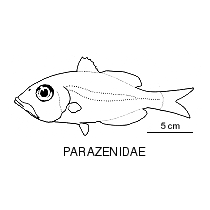- Classification
- ACTINOPTERYGII
- ZEIFORMES
- PARAZENIDAE
-
Fish Classification
-
Class
ACTINOPTERYGII Ray-finned fishes -
Order
ZEIFORMES Dories -
Family
PARAZENIDAE Little dories
Family PARAZENIDAE
More Info
|
Family Taxonomy |
The Parazenidae comprise three genera and four species worldwide, with two genera and three species occurring in Australian waters. |
|
Family Description |
Tyler et al. (2003) combined the Cyttopsidae and the Parazenidae. The family Parazenidae is now distinguished from other zeiform fishes by having pelvic fins with seven or nine rays and no spines. |
|
Family Size |
Maximum length attained is 14 cm. |
|
Family Remarks |
Mead (1957) reviewed the monotypic Parazen and Heemstra (1999, 2003) treated the known species. |
|
Author |
Dianne J. Bray |
References
Heemstra, P.C. (1999). Families Parazenidae, Macrocyttidae, Zeidae, Grammicolepididae, Caproidae. pp. 2257–2261 in Carpenter, K.E. & Niem, V.H. (eds) The Living Marine Resources of the Western Central Pacific. FAO Species Identification Guide for Fisheries Purposes. Rome : FAO Vol. 4 pp. 2069–2790
Heemstra, P.C. (2003). Families Parazenidae, Zeniontidae, Zeidae, Oreosomatidae, Grammicolepidae. pp. 1203–1216 in Carpenter, K.E. (ed.) The Living Marine Resources of the Western Central Atlantic. FAO Species Identification Guide for Fisheries Purposes.Rome : FAO Vol. 2 pp. 602–1373
Mead, G.W. (1957). An Atlantic record of the zeoid fish Parazen pacificus. Copeia 1957(3): 235–237 fig. 1
Tyler, J.C., O’Toole, B. & Winterbottom, R.W. (2003). Phylogeny of the genera and families of zeiform fishes, with comments on their relationships with tetraodontiforms and caproids. Smithson. Contrib. Zool. 618: 1–110
















